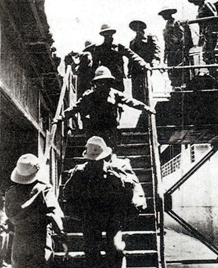 Ethiopia
Ethiopia
List for UN Allies
Background of Participation
When the UN Secretary-General asked for military assistance to South Korea in July 1950, all of the Ethiopian forces were Royal Guards, rather than combat units. Nevertheless, King Haile Selassie newly organized one battalion by selecting 1,200 soldiers from the Royal Guards. He named it Kagnew meaning, Being difficult to penetrate or to strike a fatal hit.The Kagnew Battalion, led by Lieut.
Colonel Kebbede Guebre, arrived in Pusan on May 6, 1951. The Ethiopians then moved to the UN camp in Dongrae where they were supplied with American equipment and given basic military training.
Activity of the Ground Forces
The Ethiopian 1st Battalion, which had been attached to the US 7th Division, engaged in a fierce battle for the first time on August 12, 1951. Thereafter, the 1st Battalion dispatched platoon or company size reconnaissance units several times. They destroyed enemys outposts, contributing to the operation of the 7th Division.
When the US 9th Corps in the mid-east front launched an operation to secure an advanced base to attack Keumsong, the Ethiopian Battalion also initiated an attack and occupied Hill 700 near Samhyon on September 21th. They occupied Hill 602 the next day with artillery and air fire support. In this combat, the enemy suffered 179 deaths. Later on, the Battalion was awarded a citation by the US President for their achievements. On March 28, 1952, the 1st Battalion returned home.
The 2nd Battalion of Ethiopia arrived in Pusan the next day. It was assigned to the 32nd Regiment of the US 7th Division on April 13th. It was deployed to the main resistance line around Mt. Jungga after completing training. On October 4th, the 4th Company, while patrolling, engaged in an ambush with Chinese forces, and killed 26 of the enemy. The 2nd Battalion was replaced by the 3rd Battalion, after fighting for the hills at Kalhwa-dong, west of Chulwon on April 16, 1953.On May 11th, the 3rd Battalion was deployed around Kalhwa-dong after training and maintenance. Between May 15th and 18th, CCF made four attacks on the Hill Yoke. The battalion repelled them with concentrated fire. On May 19th, 15 reconnaissance personnel intended to ambush the enemy in front of Hill Yoke in order to capture the enemy. But Chinese forces, which had detoured the ambushed unit, enveloped and attacked Hills of Yoke and Uncle. As a result, from the dawn of May 20th, a fierce hand-to-hand fighting took place around Hill Yoke. At last the enemy retreated with 110 deaths. Thanks to the achievements in this battle, the Battalion was awarded the citation from the ROK government.
Ethiopia participated in the Korean War with 3,520 soldiers, among which 121 were killed, and 536 were wounded. The ground forces withdrew from Korea gradually after the armistice. The final unit withdrew in January 1965.

